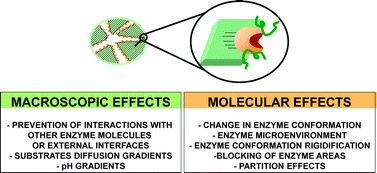Immobilization of enzymes may produce alterations in their observed activity, specificity or selectivity. Although in many cases an impoverishment of the enzyme properties is observed upon immobilization (caused by the distortion of the enzyme due to the interaction with the support) in some instances such properties may be enhanced by this immobilization. These alterations in enzyme properties are sometimes associated with changes in the enzyme structure. Occasionally, these variations will be positive. For example, they may be related to the stabilization of a hyperactivated form of the enzyme, like in the case of lipases immobilized on hydrophobic supports via interfacial activation. In some other instances, these improvements will be just a consequence of random modifications in the enzyme properties that in some reactions will be positive while in others may be negative. For this reason, the preparation of a library of biocatalysts as broad as possible may be a key turning point to find an immobilized biocatalyst with improved properties when compared to the free enzyme. Immobilized enzymes will be dispersed on the support surface and aggregation will no longer be possible, while the free enzyme may suffer aggregation, which greatly decreases enzyme activity. Moreover, enzyme rigidification may lead to preservation of the enzyme properties under drastic conditions in which the enzyme tends to become distorted thus decreasing its activity. Furthermore, immobilization of enzymes on a support, mainly on a porous support, may in many cases also have a positive impact on the observed enzyme behavior, not really related to structural changes. For example, the promotion of diffusional problems (e.g., pH gradients, substrate or product gradients), partition (towards or away from the enzyme environment, for substrate or products), or the blocking of some areas (e.g., reducing inhibitions) may greatly improve enzyme performance. Thus, in this tutorial review, we will try to list and explain some of the main reasons that may produce an improvement in enzyme activity, specificity or selectivity, either real or apparent, due to immobilization.


 Please wait while we load your content...
Please wait while we load your content...